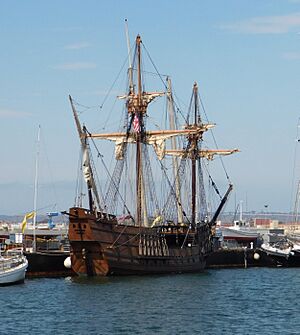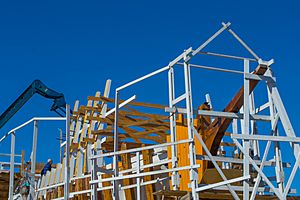San Salvador (Cabrillo's ship) facts for kids
| History | |
|---|---|
| General characteristics | |
| Length | 100 ft (30 m) |
| Draft | 10 ft (3.0 m) |
The San Salvador was a very important ship. It was the main ship, called the flagship, of a famous explorer named Juan Rodríguez Cabrillo. He was also known as João Rodrigues Cabrilho.
This ship was a large sailing vessel known as a galleon. It was about 100-foot (30 m) long. It could carry 200 tons of cargo. The San Salvador had officers, a crew, and even a priest on board.
Contents
Exploring the Coast of California
In 1542, Juan Rodríguez Cabrillo became the first European to explore the coast of what is now California. He had three ships for his journey. These were the 200-ton galleon San Salvador, the 100-ton La Victoria, and the smaller San Miguel.
The ships were built in a place called Acajutla in El Salvador. The San Salvador was named after the city of San Salvador. The San Miguel was named after San Miguel, El Salvador. The La Victoria was named after a victory in a battle.
These ships were not the usual large ships used for crossing oceans. They were designed to easily sail into small harbors. They had special triangular sails. These sails made the ships very agile. They could sail better into the wind than other ships of that time.
Cabrillo's Journey North
Cabrillo and his fleet left Navidad, Mexico, on June 27, 1542. On September 28, they discovered San Diego Bay. Cabrillo went ashore and claimed the land for Spain.
He continued sailing north. On October 7, he landed on Santa Catalina Island. He also described nearby San Clemente Island. Cabrillo gave names to his discoveries, but these names were later changed.
He sailed as far north as the Russian River. Then, he turned back to spend the winter at Santa Catalina. Sadly, Cabrillo died there on January 3, 1543, from an infected injury. His second-in-command took the ships and crew back to Navidad. They arrived on April 14, 1543.
Building a Replica of the San Salvador
From 2011 to 2015, the Maritime Museum of San Diego built a full-sized replica of the San Salvador. This new ship works just like the original. It is also historically accurate.
The ship was built where everyone could see it. This was at Spanish Landing park in San Diego. Building started on April 15, 2011. The building site was called "San Salvador Village." It opened to the public on June 24, 2011.
This project let people see how ships were built in the 1500s. This was one of the first big industrial activities in the Americas. The replica galleon is 92 feet (28 m) long. It is 24 feet (7.3 m) wide.
The Replica's Launch and Tours
When it was finished, the new San Salvador was launched into San Diego Bay. It became part of the Maritime Museum's collection of historic ships. Construction was almost done by April 2015. A launch ceremony was planned for April 19, 2015.
However, the ceremony was postponed due to some technical issues. The ship was later moved by a barge to a boatyard in Chula Vista.
The replica made its first public appearance on September 4, 2015. It led a parade of tall ships for San Diego's Festival of Sail. At that time, it used an engine because its sails were not ready. It opened for public tours in September 2016. Now, it regularly sails for public sightseeing tours.
In 2018, a part of its sail system, called the mizzen lateen yard, was replaced. The original part was too heavy. This made it hard to steer the ship. It also could have damaged the mizzen mast. It took many crew members to remove the old part. Only a few were needed to put the new, lighter one in place.
A Model of the San Salvador
Cabrillo's ship, the San Salvador, is thought to have had four masts. It had a square-rigged foremast. It also had lateen-rigged main and mizzen-masts. There was an even smaller mizzen-type mast with a boom. This boom swung out like a modern yawl boat.
The ship La Victoria is described as having two masts, both with lateen sails. A model of the San Salvador was built by Señor Manuel Monmeneu. He worked with the Naval Museum in Madrid, Spain. The Portuguese-American Social and Civic Club of San Diego helped fund this model. This model shows the San Salvador looking more like La Victoria, with two main masts.



